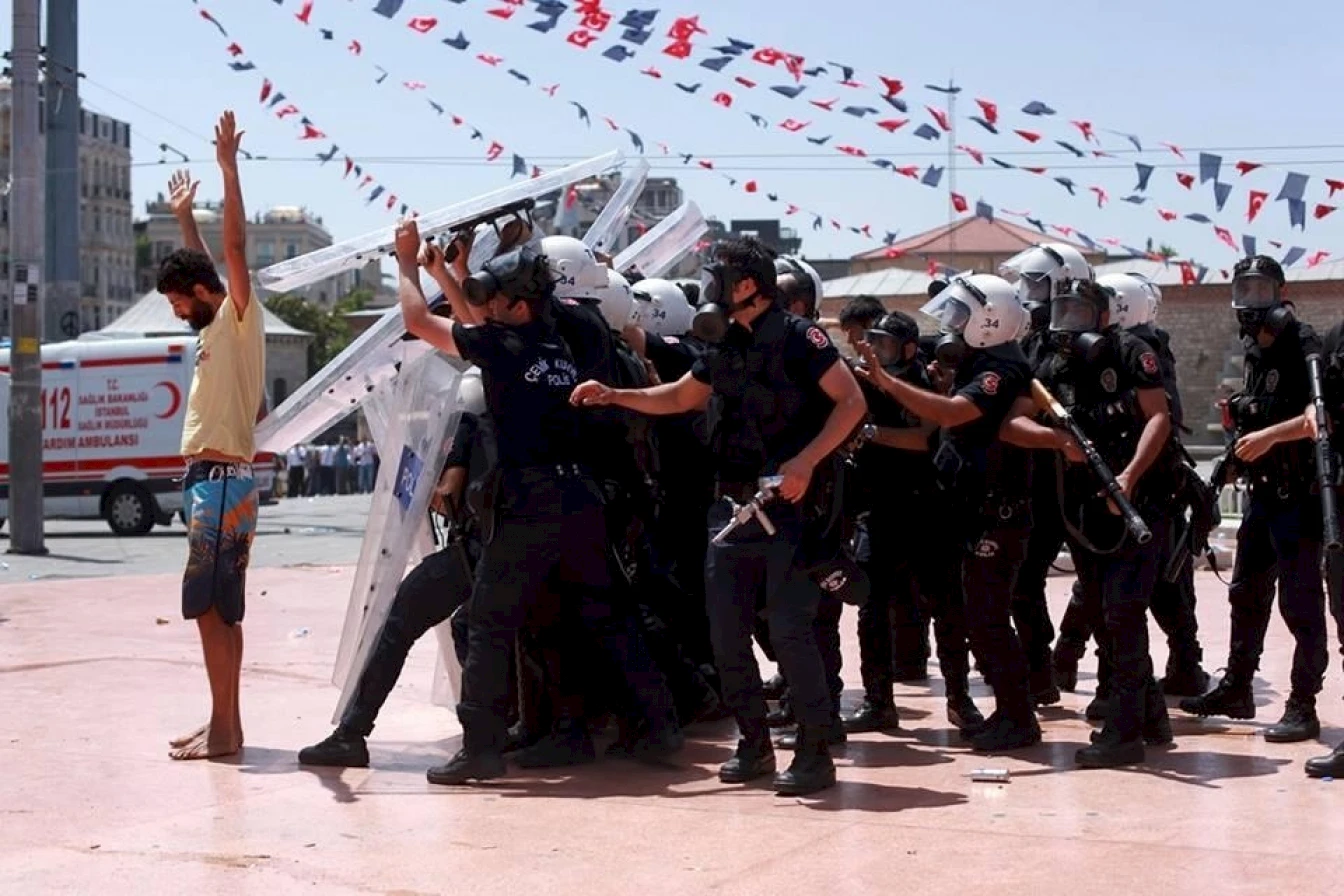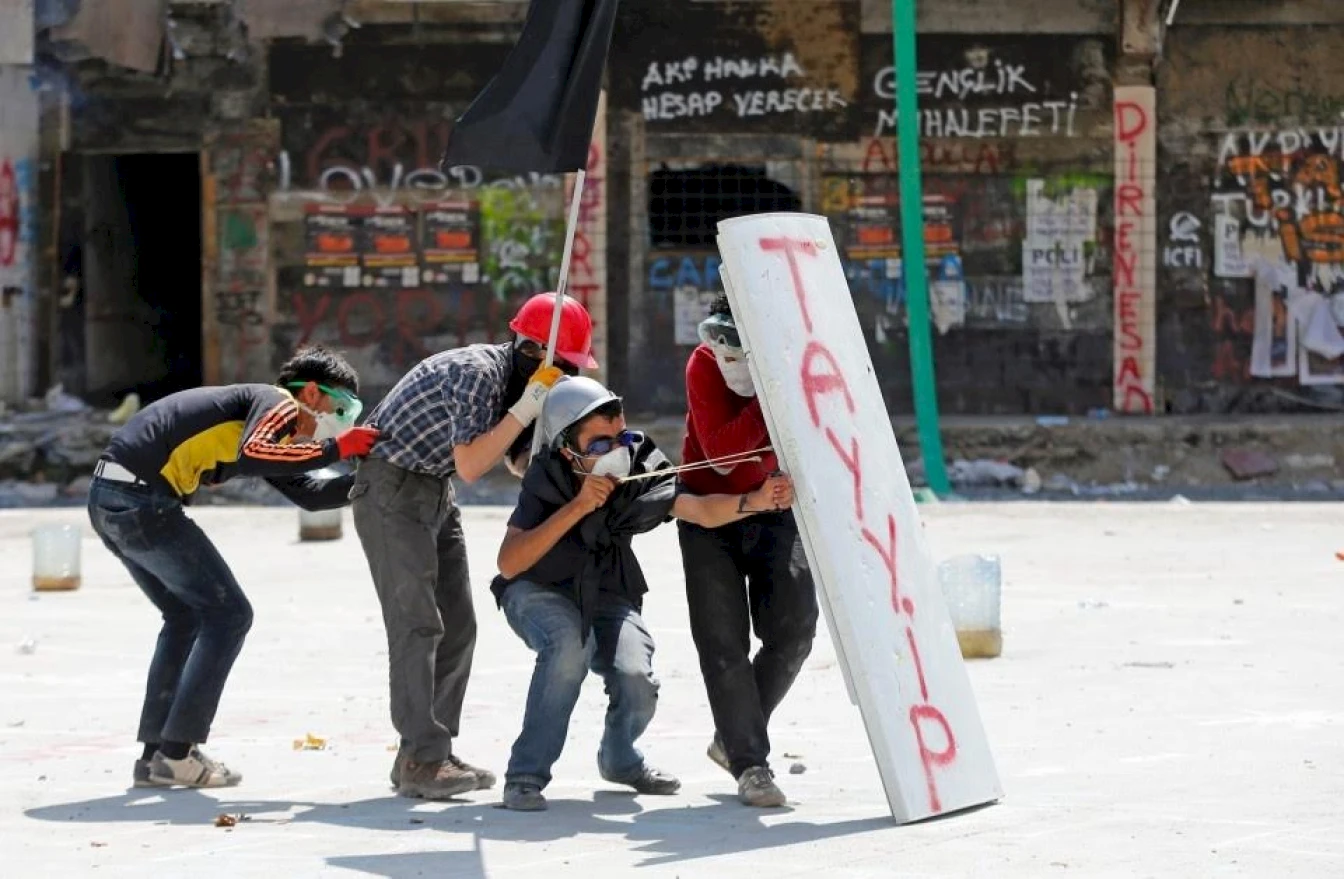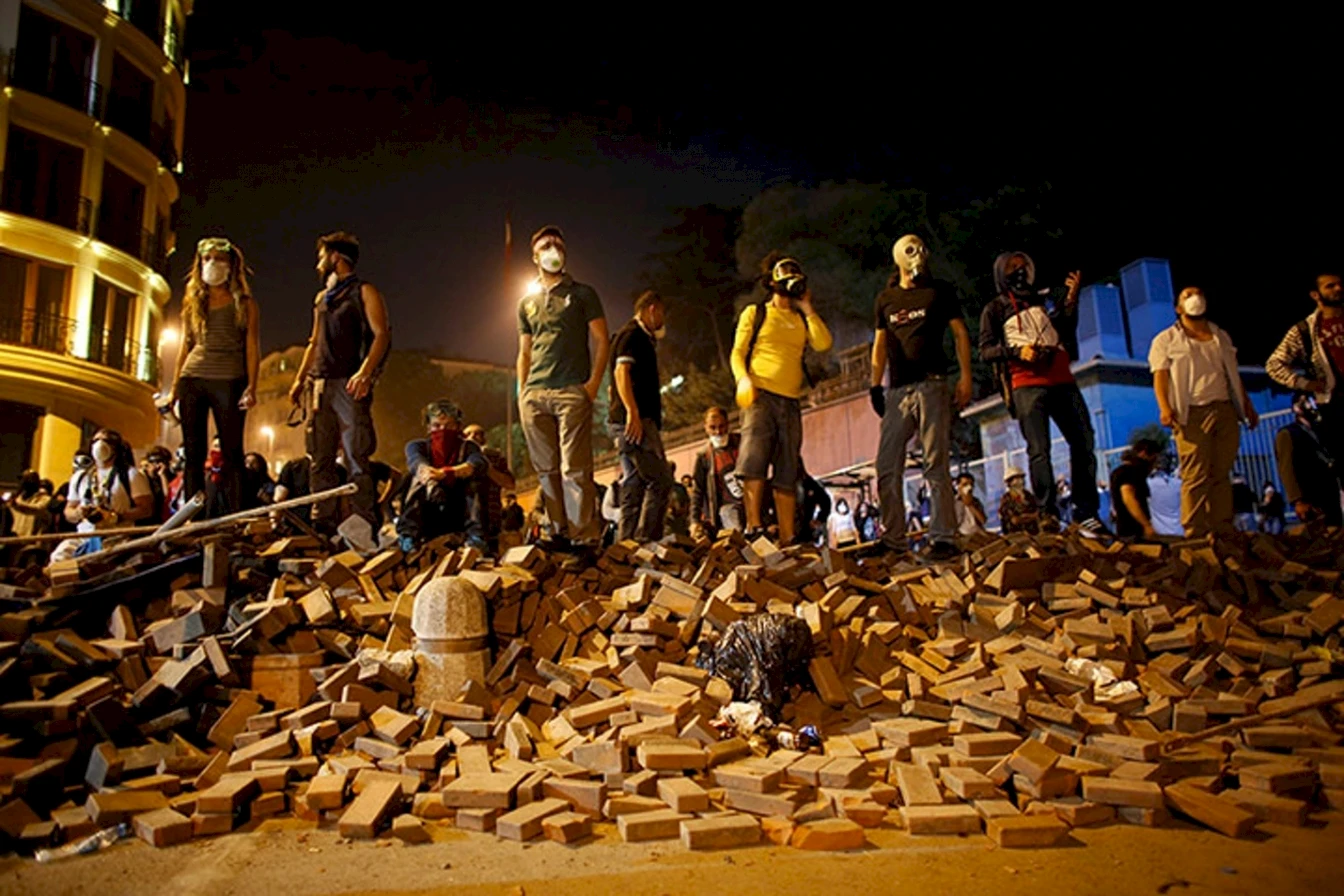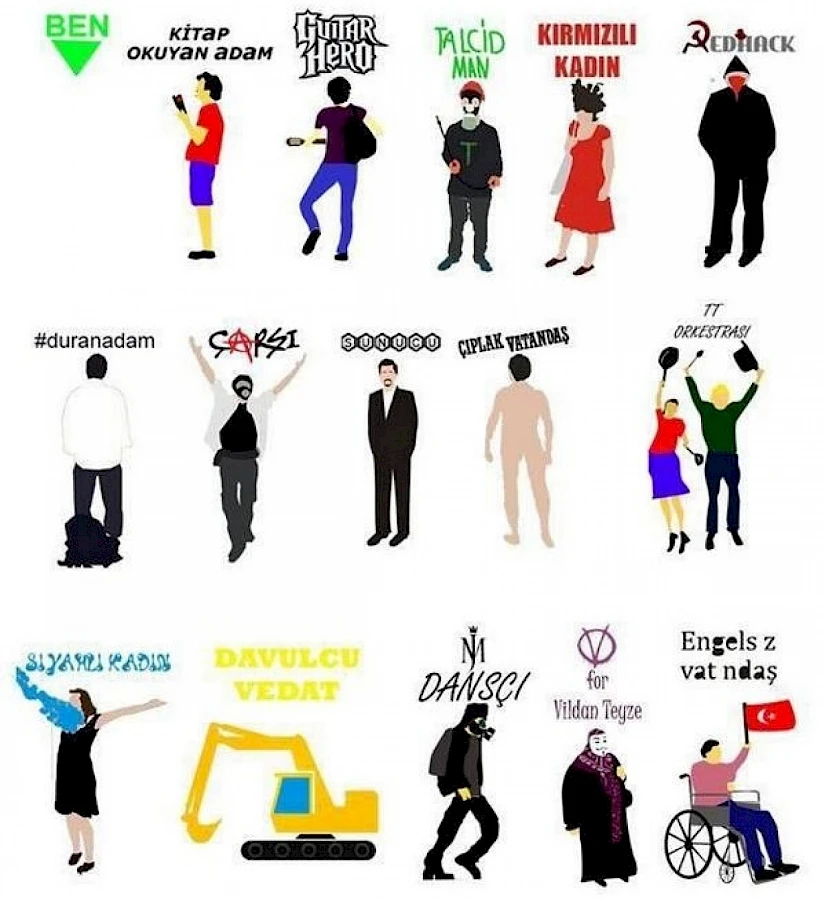Resistance and Resignation: Learning From "the Streets"

Yücel Tunca/Nar Photos.
This article was finalised almost two years ago and many things have changed in Turkey since then. Even if we don't feel as powerful right now, in November 2016, as the title suggests, I wanted to keep the feeling of the times when the articles was written. I believe the shifts in history cannot be undone and that the dormant tools and discussions will be called back as soon as we have a little space to breathe again.1
How can people challenge established and institutionalized forms of vertical authority? What can we learn about practice of contestation from how they are exercised in the "real world"? How can the activist practice of confronting "low-intensity representative democratic institutions" with "participatory or high-intensity democratic forms of democracy and self-determination"2 inform the attempt to theorize disobedience? Asking these questions, i.e. starting from the practice of dissent "on the streets", is especially relevant in the case of civil disobedience, since the theoretical discussion about this political practice – a practice with a rich and contested history that stretches from Henry David Thoreau via Mahatma Gandhi and Martin Luther King, Jr. to Occupy (and in this latter case from New York to Hong Kong) – has been marked by a number of systematic shortcomings. These shortcomings are largely due to theorists' at least partial ignorance of, and only very selective attention to, the complex reality of disobedience, leading many of them to a simplified and depoliticized understanding of this practice.3
In order to counter this tendency, in what follows I will sketch some theoretical lessons that can be drawn from "the streets", and in particular from the recent uprising in Turkey, which started on May 28, 2013, and which died down over the summer and only occasionally regained momentum since then. Despite its limited immediate impact on the Turkish political system, this uprising - often referred to as the "Gezi Uprising" although it involved many other less prominent neighborhoods that have historically experienced much more sustained forms of police violence - has become a prominent episode in the cycle of global protest that started with the so-called Arab Spring (a problematic designation that tends to invisibilize the long and sometimes subterranean history of struggle and resistance in these countries, a "prehistory" without which the "spring" would not have been possible). Initially, the protests in Istanbul had first focused on the neoliberal transformation of urban space and its disastrous ecological and social consequences; and after that, they spread out socially (in terms of participants), geographically (in terms of neighborhoods and cities involved) and politically (in terms of both the substance of the demands that were formulated and the way in which they were formulated) – their political and theoretical significance, however, is even more far-reaching.4
Highlighting some central aspects of these protests will serve to indicate three ways in which the practice of civil disobedience is more complex and also more political than it is suggested by the mainstream understanding of it. According to this common understanding, civil disobedience is primarily or exclusively a symbolic and nonviolent act of protest of "concerned citizens" that involves breaking particular laws without challenging the legitimacy of the existing order. The three aspects I will focus on are 1) the meaning of "civil" in civil disobedience, 2) political mobilization and the essentially collective character of civil disobedience, and 3) the inventiveness of the practice of civil disobedience in terms of the repertoire of political action that goes beyond the simple dichotomy of a merely symbolic appeal on the one hand and violent militancy on the other.
I The Civil Violence of Civil Disobedience
Referring to the first point above: What, then, is civil about civil disobedience? It is well worth emphasizing the civil and civic character of the protests in Turkey which is all the more remarkable since it is the outcome of massive self-restraint in the face of the enormous aggression and repression exercised by the government and its security forces and the evident power asymmetry they imposed on the movement from the very beginning. Against this background, the civility of the movement should be understood as an expression of political commitment rather than – as most liberal accounts would suggest – a sign of loyalty to the state or the existing order; in addition, as Gandhi and King already knew, civility in this sense is a significant political achievement and the invariably precarious outcome of an individual and collective – and most importantly: continuous – work on the self.5 The dual character of civility as ethical and political is exemplified in the protesters' refusal to engage in the political game of "othering" (ötekileştirme), immediately taken up by then-Prime Minister Erdoğan who referred to the protesters in a derogatory way as "çapulcu" (looters and vandals).
In mainstream discourse, the "civil" in "civil disobedience" is often taken to mean that protesters do not engage in confrontational, aggressive or violent behavior, that is, it is regularly identified with (often romanticized and one-sided interpretations of) the idea of nonviolence and peacefulness. Whether that is convincing, however, of course depends on how precisely violence is understood and the problem here is that it is an extremely contested and politicized notion. A related problem is that this identification of "civil" with "nonviolent" is often based on a biased understanding of the activism of Gandhi and King and the broader context of the movement for independence in India and the American Civil Rights Movement, and more recently also of Nelson Mandela and the African National Congress, which, in some cases, amounts to historical whitewashing.6
My point here is not that we should develop a better theoretical definition of violence that could subsequently be applied to the practice of disobedience. What I argue is that it is problematic, both, politically and theoretically, to understand violence and nonviolence in theory and practice without problematizing these two concepts, without paying more attention to how the distinction is politically instrumentalized, but merely insisting on the nonviolent character of civil and civic forms of contestation. In this light we have to remind ourselves that in many countries, including the Netherlands, Germany and Turkey, it can nowadays count (not only in public opinion but also in a court of law) as an act of violent coercion to collectively stand in one place, to sit down on the street or to make fun of the ruling authorities; that trespassing or damaging private property is regularly subsumed under the notion of violence, thereby assimilating them to serious violations of the bodily integrity of real persons; that more recently, forms of digital disobedience – from the leaking Wikileaks and Edward Snowden engaged in to the DDoS-actions of Anonymous – are criminalized as forms of cyber-vandalism and -terrorism, with activists being prosecuted, convicted and jailed without any acknowledgement of the political and moral character of their actions.
The pattern that emerges here is a feature of repressive tolerance in Herbert Marcuse's sense: Governments pursue a strategy of divide and conquer with regard to protest, portraying and celebrating certain forms of protest as 'good' (good in terms of who protests, how they protest, and with what aim) and labeling and repressing other forms of protest – often those of marginalized groups – as 'violent', 'uncivil' and 'criminal'.7 This strategy is obviously not limited to Turkey – think of the official reaction to the political unrest in the French banlieues in 2005 and in London in 2011, immediately disqualified as "senseless rioting" and even framed by theorists as "issueless" or driven by "consumerist desires", i.e. as non-, pre- or even anti-political, despite plenty of evidence for it being a reaction to the violation of genuinely political claims of citizenship.8 In such a context, describing an event, activity, person or group as "violent", far from being a neutral observation, is also always a politically charged speech act that can reproduce forms of marginalization and exclusion that are often racialized and gendered.
Instead of simply identifying the civil and civic character of collective action with "nonviolence" we should therefore insist that civility is quite compatible with a variety of actions often classified as violent. The first of these is violence against oneself. As it is well-known, especially in the Turkish context, this form of violence plays a crucial role in the repertoire of action of protest movements, recently underlined by the self-immolation of Mohamed Bouazizi which was a catalyst for the mobilization of the people in Tunisia in December 2010.9 The second is violence in self-defense – think of (often, but not always) relatively minor forms of violence in defense against police aggression, e.g. in the form of defending barricades against attempts by the police to storm the occupied park or square, as in Istanbul or Kiev. The third category is perhaps most obviously compatible with the civility of protest, namely the (limited) destruction of private or public property which is also often considered as violent. These forms of violence, if we want to call them that, can all be eminently political – and civil as well as civic, I would argue – in reasserting the political agency of those who engage in them against the forms of domination, exclusion or marginalization which they are subjected to. What is more, the debate about what counts as violence, and which forms of violence might be politically mandated or acceptable, is an integral part of the discourse that takes place within movements and struggles, so that one cannot simply blame them for unthinkingly or uncritically engaging in destructive behavior.

Murad Sezer/Reuters.

Murad Sezer/Reuters.
Against this background, civility cannot be understood as requiring citizens to be polite, considerate, reasonable, and well-behaved under all circumstances, especially given the socially-coded and class-dependent meanings of the underlying norms of "civility". What is decisive for the civility of protest is thus not that it is nonviolent in a sense that would exclude the forms of action listed above or that it is purely symbolic and remains "peaceful" and "civilized" (although movements of course often make that choice for strategic reasons, so as not to alienate influential parts of the population that are averse to more disruptive and radical forms of claim-making). Rather, what establishes the civility of protest is that it does not follow a military logic or replace civil and civic resistance with armed force aimed at the physical destruction of an (imagined) enemy. Those who engage in civil and civic practices of disobedience and contestation continue to act as citizens – indeed they exemplify what it means to be a citizen –, and thus acknowledge some kind of civil bond with their adversaries. Hence, in the case of the Gezi uprising, the civil character of the movement – despite its engagement in sometimes confrontational and even violent forms of action – prominently expresses itself in the radical refusal of seeing the other side as the "enemy" and of playing the established political game of polarization and defamation.10 I will return to this prefigurative politics of the movement below.
Also in this respect, however, it is important to acknowledge that a political struggle that imposes limits on itself in the light of such an internal relation between means and ends can engage in forms of resistance that are seen as, and sometimes also intended to be, violent. Here we only have to think of the struggle of the African National Congress and its armed wing Umkhonto we Sizwe, and more specifically of Nelson Mandela's justification of the decision to resort to violence – especially in the form of sabotage aimed at infrastructure, not of violence directly aimed at individuals or of "terrorism" – at the Rivonia Trial in April 1964, after a long time of unsuccessful attempts to end racial injustice by peaceful means. Although that struggle clearly went beyond civil disobedience, it is unclear why it should not be characterized as civil and civic in light of the ethical and political self-limiting commitments that informed it.
The first lesson to be learned is thus that civil and civic forms of resistance are not reducible to purely symbolic means of protest – even occupying a square or an intersection is obviously more than symbolic. In order to retain their effectiveness, civic forms of protest in general and civil disobedience in particular will have to be careful in many circumstances not to be reduced to their symbolic dimensions; they have to keep a confrontational character as well – not least in order to defend their civil character. Civil disobedience can only function as symbolic protest – as dramatization in Martin Luther King, Jr.'s sense11 – if it involves moments of real confrontation, such as practices of blockade and occupation as well as digital forms of activism such as hacking, and at the same time it can only function as real confrontation if its participants are aware of its irreducible symbolic dimension – the fact that it is always also a performance in need of (and in search for) a stage and an audience. It is one of strongest indications of the radically democratic character of recent protest movements – from Occupy to the Gezi uprising – that they developed new forms and practices for this constant internal self-reflexivity, which prominently includes reflection concerning the relation between means and ends and the distinction between violence and nonviolence, whether one agrees with the outcome of these reflections or not.
II Mobilization
The second lesson which theory can learn from practice concerns the question of political mobilization. I do not mean this in the sense of looking for a single set of "objective" causes that can explain why people start to rise up. After the event, social scientists are quick to point to shifting patterns of social mobility, urban transformation and clashing political cultures as the causes of what happened, but in the case of the Gezi uprising as with the so-called Arab Spring these are largely ex-post rationalizations, since – despite the significant histories of struggle in all these cases – no one was able to predict these events. Importantly, this includes the activists themselves who have been equally surprised by the dynamics of the chain of events they have set in motion. Of course, as Zeyno Pekünlü reminds us, activists had been preparing, creating collective spaces, forging collaborations and developing new vocabularies, especially in the Resistanbul movement against the World Bank and IMF summit in Istanbul 2009, the Migrant Solidarity Network, and the struggle against the demolition of the landmark Emek Movie Theater. However, no one really knew for what they were preparing, until it happened – and when it happened, the preparation, the collaborations and informal infrastructures, experiences and skills proved crucial.12
This sense of surprise has to be preserved against the urge to explain and to fit what happened into all-too-familiar historical patterns and narratives. It was precisely this sense that led Edgar Morin, Claude Lefort and Cornelius Castoriadis to write their famous intervention La Brèche at the height of the Paris May 1968 uprising, defending the radical character of this opening against all attempts to reduce it – politically, sociologically, or historically – to a generational conflict, economic frustration or romantic anarchism.13 Of course, people have myriads of reasons to protest, but for such politically and socially heterogeneous groups to come together and to be so resilient in the face of repression and criminalization something else has to happen. What is this something else, this unexplainable and unpredictable remainder that seems to drive collective action?
In order to grasp this dimension of the practice of disobedience one has to move beyond the individualist focus of liberal theory and the spotlight the media puts on individual heroes of the rebellion, such as, in the case of Turkey, the famous "woman in red" or "Talcidman" – as important as their role might have been as metaphorical figures that became representatives of the uprising. Instead, we have to take the essentially collective character of civil disobedience into account. The dynamics of collective action is of course difficult to theorize but it is an essential aspect of most first-hand accounts and shapes the experience of protesters. When theorists try to capture this dynamic rather than explain it away or ignore it or pathologize it (as has been the case in crowd- and mass-psychological approaches that have emphasized the irrational and destructive character of group action), they often resort to relatively metaphorical language. Think of the empowering collective experience of overcoming fear and what Hannah Arendt calls the joy of acting together and of beginning something new (although, in contrast to heroic and masculinist portrayals of the protester, this joy is of course often, if not always, accompanied by fear and panic and the awareness of the risk of getting attacked, injured, arrested);14 of Jean-Paul Sartre's marvelous analysis of the storming of the Bastille at what would later become the beginning of the French Revolution in terms of the "groupe en fusion";15 or of Michael Hardt and Antonio Negri's multitude in which plurality and creativity come together in the emergence of new political subjectivities – and what is it that these movements exemplify if not the ability of the multitude, usually denied by the state and its representatives, to reject being governed like that and to organize and govern itself?16
Without taking this first-person perspective, this phenomenology of protest, into account, we – or future theorists, sociologists etc. – will never come to an adequate understanding of why and how people do what they do in an uprising. In contrast to what the liberal mainstream suggests, this is rarely a matter of isolated individuals standing up for their rights or their conscience against the state or the majority. Of course, as Julian Assange, Chelsea Manning and Edward Snowden attest, exemplary individuals can transform established ways of conceiving of political action and invent new articulations of the art of revolt.17 More often, and paradigmatically, however, civil disobedience is the collective assertion of political agency, which confronts the vertical form of state and corporate authority and its institutional realizations with the horizontal and informal power of the association of citizens or the governed, thus creating new political subjectivities both at the individual and collective level that might well turn out to be the most transformative effect of such an uprising.18
III Expanding the Repertoire of Political Action
The third aspect of disobedience about which theory can learn from practice concerns the repertoire of political action. Tahrir, Zuccotti, Syntagma, Taksim, etc.: Obviously these names with which we are now all so familiar point to very different contexts, in which very different aims, agents, strategies are at play, but as many commentators have pointed out there still seems to be something like a shared emerging political form: All these protests have prominently involved occupations of public space, i.e. democratic acts of reclaiming and reappropriating this space – on a more than purely symbolic or metaphorical level – as something that already belongs to the people who use it on an everyday basis but that is threatened by both neoliberal privatization and authoritarian state control.19 This kind of prefigurative politics - characteristic of recent protest movements and most prominently exemplified in Occupy - experimentally anticipates the transformation it seeks to initiate in the way the struggle is organized here and now: in a horizontal, participatory, inclusive and civil way, thus breaking not only with the authoritarian state and the politics of the right but also with the vanguardist tradition of the militant left.20 Accordingly, these occupations are prefigurative in that protesters organize these spaces by way of precisely those political and social relations that the protest is supposed to defend and aim at simultaneously.
This prefiguration has a radically democratic meaning in that it instantiates a form of democracy that conceives of itself as standing at a distance from the state. In this way it highlights the gap between the official self-presentation of the state as a constitutional and representative form that exhausts the meaning of democracy – as a well-ordered democracy to which there is no alternative – and an alternative understanding of democracy as emerging out of the collective exercise of power on a grassroots level.21 It is precisely this democratic and democratizing role of protest movements that has important political implications, even if the movement fails to change political power structures in a sustainable way. As Costas Douzinas points out, "Social movements have literally taken on the role of the 'collective intellectual' of the working population: [...] They put into political practice skills, aptitudes and networks people have to learn and use for their daily work. In this sense, socio-political movements have much more advanced and accurate views of popular grievances and possible solutions than political parties which, through necessity, concentrate on parliamentary politics and state institutions"22
In addition to this general characterization, there seem to be at least three shared features of the occupation of public spaces by these movements and of the prefigurative and radically democratic practices realized within them: Firstly, these movements are all committed to plurality in terms of ideological commitments, identities, aims, strategies and forms of organization and collectivity – in the case of Turkey this is again especially noteworthy against the background of a decidedly anti-pluralist political culture characterized by wide-spread patriarchal, nationalist and paranoid tendencies. Secondly, its prefigurative politics emphasizes the autonomy of the movement and the way in which it creates its own spaces, independently from the state and the private sector, effectively ignoring their existence (this is the "exodus" component of this form of protest), organizing and protecting in their own way the plurality of bodies that make up the protest movement.23 This prefigurative politics can take a variety of forms that exemplify what it could mean to understand democracy not merely as a set of formal institutions and procedures but as a "form of life" or collective association. Reaching from use of the Internet – especially social network sites such as Twitter and Facebook – to create one's own alternative public sphere in opposition to the politically controlled media apparatuses24 via establishing networks of care and support (e.g. in terms of medical assistance and food supply) to building barricades to defend the occupied space against attempts of the police to again bring it under control, the repertoire of prefiguration cuts across the divide between the symbolic and the confrontational. In this respect it is crucial that the prefigurative character mandates a self-reflexive and self-critical form of political practice that continually interrogates its own presuppositions, structures and implications – and this is indeed what, despite all obstacles and challenges in terms of organization, the forum- and assembly-centered non-hierarchical politics of these movements has aimed at approximating.
The third aspect – the creativity of the uprising – has been prominent in media coverage but often represented in a trivializing way by isolating specific instances of humorous intervention from the broader context of the movement and its more confrontational tactics. In that context creativity is a form of constantly expanding the repertoire of contestatory collective action. In the case of Turkey endless examples illustrate that this has happened with an astonishing frequency, from the initial occupation via the barricades and the humor expressed in posters and street graffiti to the "standing man" and the proliferation of public park forums – leading participants and observers to speak of the movement's use of "disproportionate intelligence" (orantısız zeka). This creativity is important for addressing a variety of problems protest movements face, from responding to, and evading, state practices of control and criminalization, via the problem of cooptation and integration into the realm of normalized culture (a.k.a. the commodification of protest – indeed it did not take long until the first Occupy Gezi T-shirts and coffee mugs were sold on the web), to the problem of what in social movement studies is called the exhaustion of the repertoire of collective action: the fact that when confronted with established forms of protest people tend to react by shrugging their shoulders, effectively neutralizing the disruptive potential of these forms of protest (say demonstrations and sit-ins) and in turn dampening the protesters' enthusiasm and frustrating their ambitions.
It is in this political context – and not in the decontextualized collections of funny banners and graffiti in exhibitions or catalogues – that the creativity of activism has its place. At the same time, this context is increasingly transnational, and here we encounter another remarkable characteristic of the recent wave of protest: Despite its primarily national focus in many cases – which stands in some contrast with the transnational orientation and constituency of the earlier Global Justice Movement –, the protests have contributed to the enactment and constitution of transnational public spheres in and through novel contestatory practices. These practices now prominently feature an increasingly global culture of contestation often built around visual and other nonlinguistic media of communication (the ubiquitous Guy Fawkes mask provides the most well-known example of this trend), which might give rise to new forms of transnational solidarity.

Symbols of Gezi Protests, Wikimedia Commons.

NTV Tarih Dergisi Yasarken Yazilan Tarih, Wikimedia Commons.